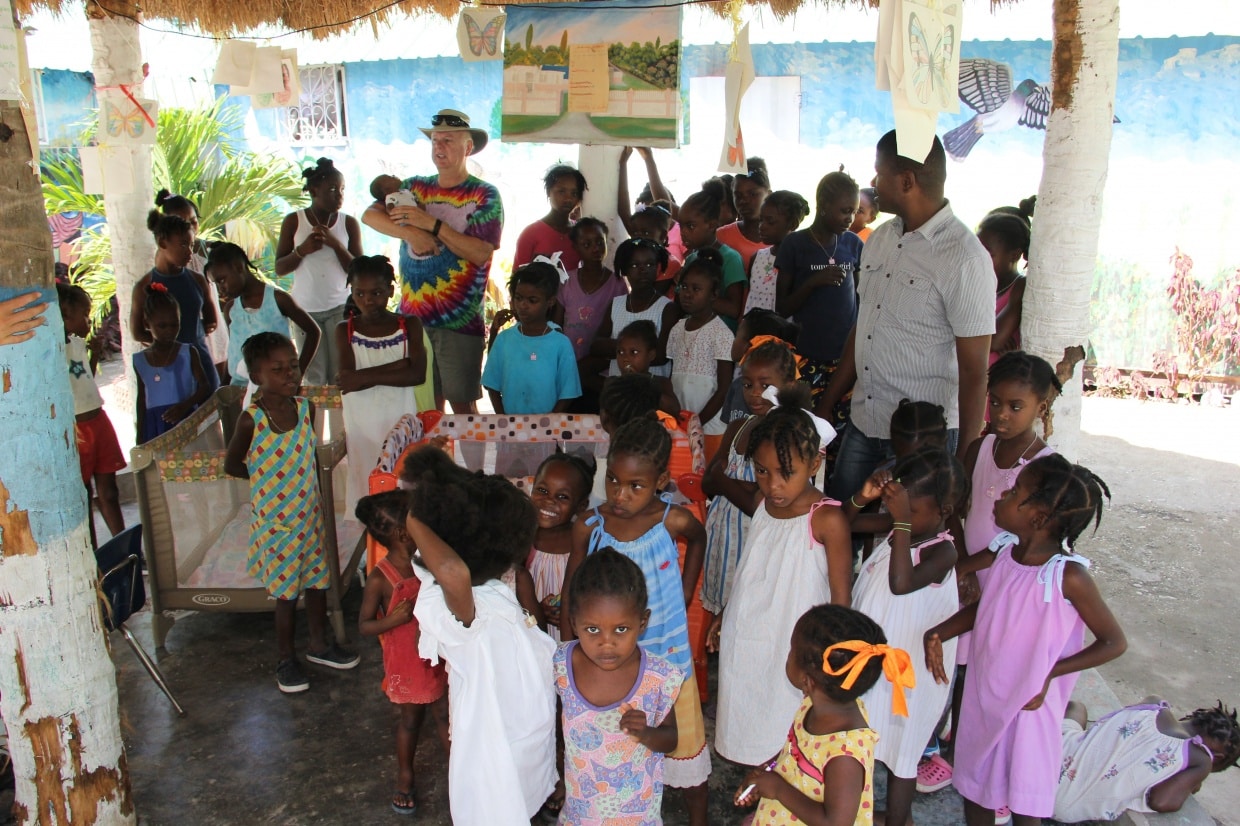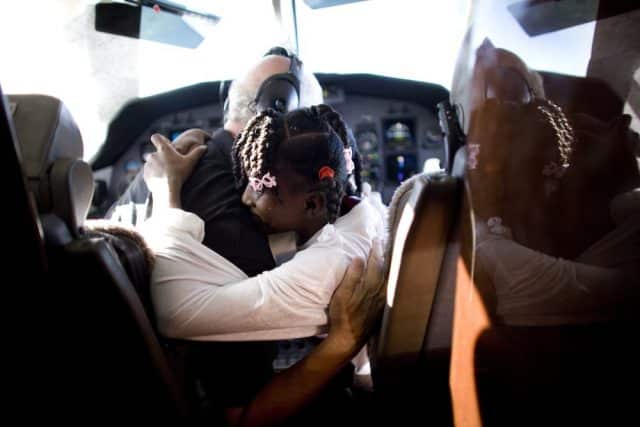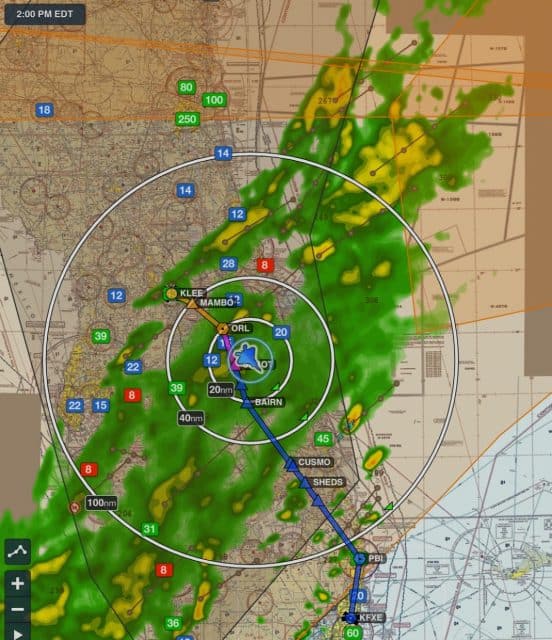A Little Background
In 2010, over a span of 3 weeks, with the generous support of aircraft owners who gave me access to their planes, friends who helped financially, and those that helped with flying, I was able to make over 70 flights in support of earthquake relief efforts in Haiti. Ever since leaving Haiti on March 17, 2010 I wanted to return and continue to help where possible. It wasn’t until this year, 2014, that I was able to accomplish that goal.
Haiti has held a strong pull on me since that first landing in Jacmel Haiti on Feb 4 2010. Prior to the Haiti flights, I had flown over 20 flights through the Bahamas, and visited numerous Caribbean islands. Flying to Haiti never crossed my mental radar, and was never on my list of islands I wanted to visit!
On my first first to Haiti in February 2010, I found people who survived a horrific natural calamity and living in extremely challenging conditions. I also found a resilient people with a captivating culture and beautiful art who I hoped to help in whatever ways possible. Some of those flights are detailed in my earlier Flight Logs .
One of my favorite photos during my 2010 trips was taken by a friend and professional photographer, Robert Caplin. Robert took a number of wonderful photos of flights we flew together. Daphka had her leg amputated and I was flying her to the States for additional care. She was my co-pilot at FL270 (27,000 feet). I didn’t know any Creole and she didn’t know any English, but somehow we communicated.
I first learned of the Consolation Center (Centre le Reconfort) Haiti Orphanage, located in Les Cayes , during a flight with my friend, Brandon Campbell, when we flew a PC-12 into Les Cayes airport (MTCA) to bring supplies to Dr. Robert Leger. After the earthquake people were fleeing Léogâne (the epicenter with 80-90% of buildings destroyed) and Port-au-Prince to the outlying areas for medical assistance. Dr. Leger was the only surgeon in Les Cayes at the time and hence the primary physician helping victims. I later met one of his first patients, a young girl, on one of my flights. She was the first to have a limb amputated in Les Cayes.
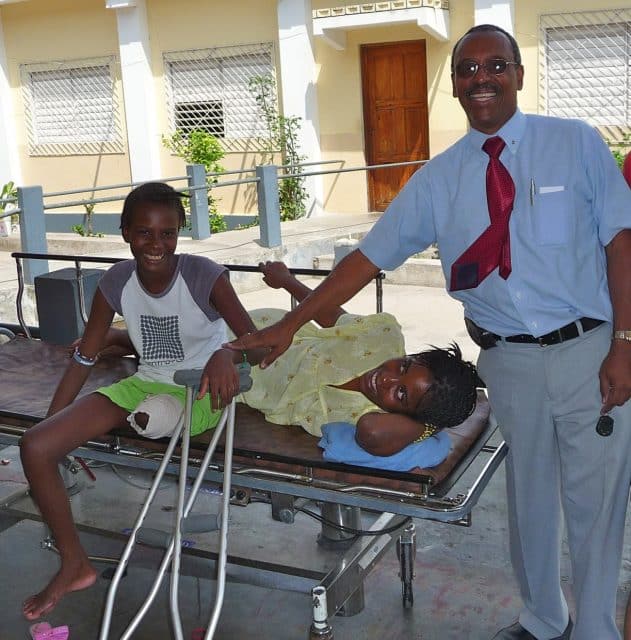
Dr. Leger with his first amputee patient and her adopted sister
In March 2010 during a second series of flights in a Piper Meridian, I first visited the Consolation Center itself with our son Rick, after having earlier met Yvald Francois who helped at the orphanage. At that time 15 young girls were living in a very small building with very little food. Over the course of a week we flew daily trips from Cibao International airpot (MDST) in Santiago, Dominican Republic, bringing them a large amount of food, supplies, toys, and additional medical equipment for Dr. Leger. We would find out what they needed then search the warehouses at the Santiago airport for x-ray film, medicine, sutures, and food. We flew over the mountain range that separates the two countries, almost always in Instrument Flight conditions (IMC). In this photo you can see two building thunderstorms with significant precipitation. The farthest cell is partially shadowed by the closest cell. We are at 28,000 ft MSL and the cell tops are at 30,000 ft MSL.
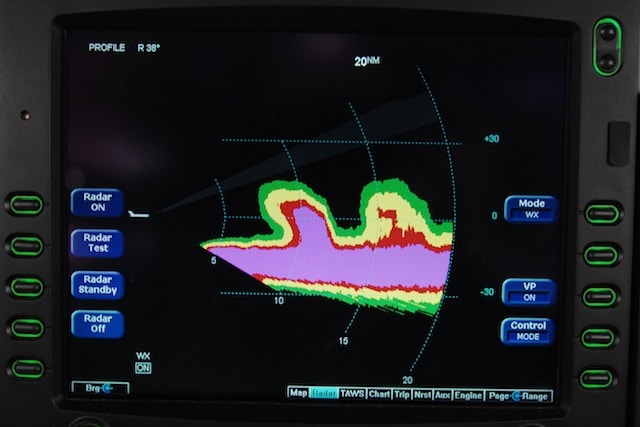
Vertical RADAR profile of cells over the Central Range between DR and Haiti. The cells are 38 degrees to the right.
In 2010 the Consolation Center was in the process of building their first structures, with the help of sponsors in the United States. An engineer in the US had designed buildings using discarded shipping containers, and grain silos!
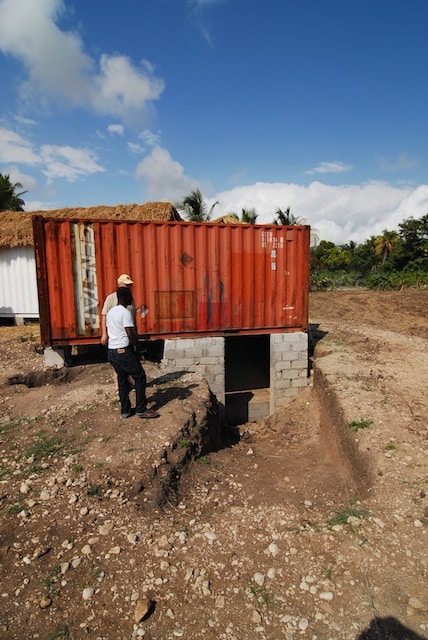
Composting toilet using a shipping container
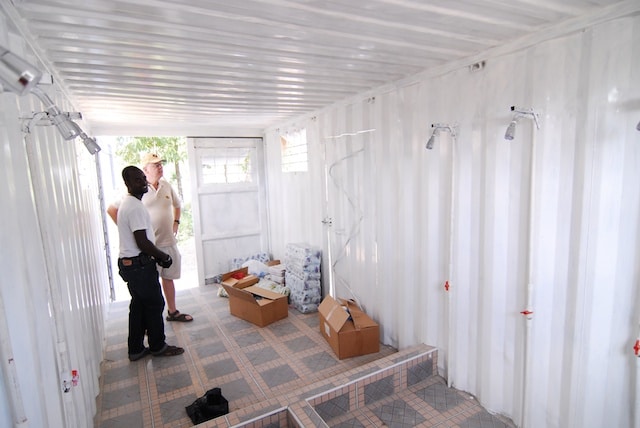
Yvald and Rich checking out a shipping container converted to a bathroom
They were designing a sustainable center, with composting toilets, sufficient agriculture to support the children, and a new co-ed school. Since 2010 we have also held an annual ‘Hope for Haiti’ benefit at SDSU sponsored by our Black Science Students Organization (BSSO) for the Consolation Center.
Our last flight from Haiti back to San Diego was from Les Cayes on March 22, 2010. We were trying to help 2 young girls who were at risk of losing their limbs from infection within the next 2 days. After working with their medical teams and ensured that the UN could do the medevac in their helicopter, we headed home. Rick and I knew we would be back.
Flying to Haiti: My first return visit since 2010
It took more time than I had hoped to fly back to Haiti. I started planning the return flight in earnest, in February 2014, a trip that would subsequently cover 6500 miles (5650 NM). After contacting Eddy Constant, the Consolation Center Director, we decided the highest priority would be to improve the availability of technology for the school of 300 children that is run by the Center. A friend generously offered to purchase 8 Android tablets for the school and the search for pre-trip supplies was underway!
The center’s only internet is a single 2G cellular connection so I planned to install a wireless network to provide access, albeit slow, for the tablets and the few old computers they had. I also knew that school supplies are difficult to obtain, so we loaded up on those as well as crafts for the kids. I don’t like to have extra room on the supply flights and also wanted to help my friend, a physician from Alabama, who donates substantial time helping in Port-au-Prince. He was one of the first physicians to fly down to Haiti in 2010, flying his Cirrus SR22 down and subsequently saved many lives. It was his photographs and emails that told a story I could not resist. To this day, he flies his plane to Haiti many times a year. I knew he could use some help delivering supplies to Haiti so I called him up. He and other colleagues had procured medical supplies that would be helpful at St. Damien’s, a pediatric hospital in Haiti. We scheduled a detour in our flight out to Haiti to bring them down with us.
The plan was now set: fly my Cirrus SR22 N412DJ from San Diego to Haiti loaded with supplies, pick up some medicine along they way in northern Mississippi, then head to Haiti via Florida and the Bahamas. A friend, George Mazis, who is also a pilot, offered to share expenses and share the piloting. We also decided to stop by the Bahamas on the return trip, which was a bonus!
San Diego to Florida
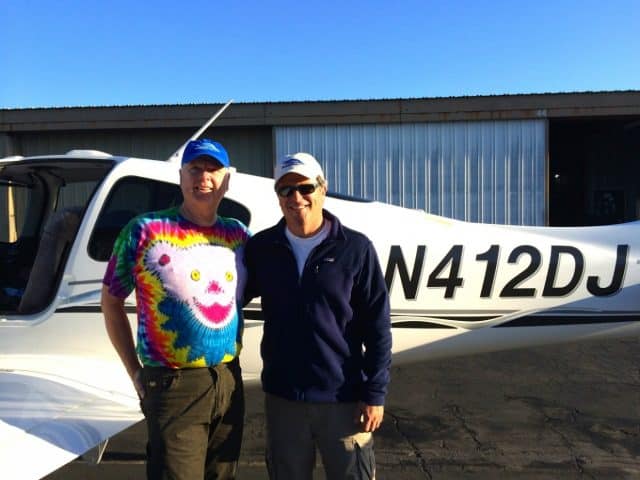
Rich and George Ready to Rock at MYF for Haiti
Two days into our trip, we spent a total of 17-hours chasing a strong storm ahead of us. Our destination was Meridian, MS where medical supplies were waiting for us. The onboard weather in my SR22 indicated large areas of heavy precipitation, cyclonic activity, and hail. We decided to stay over in Lufkin, TX to wait it out.
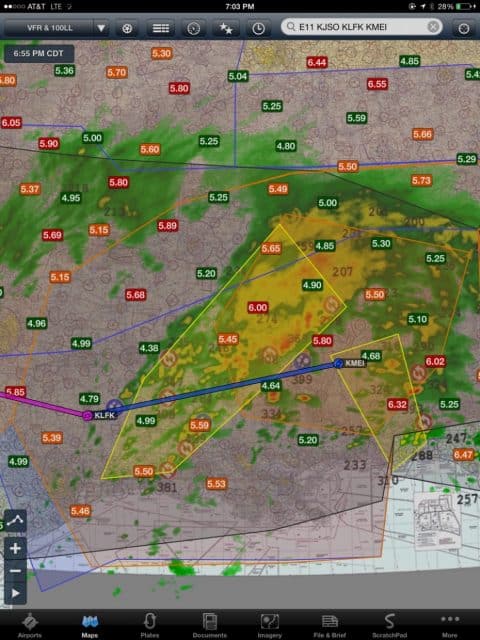
Significant weather along our route – SIGMETs, AIRMETS and precip
After an overnight stay in Lufkin Texas (KLFK) (a great place to stay with good fuel prices) we diverted north a bit to John Bell airport (KJVW) in Raymond, Mississippi to pick up medicine for St. Damien’s hospital.
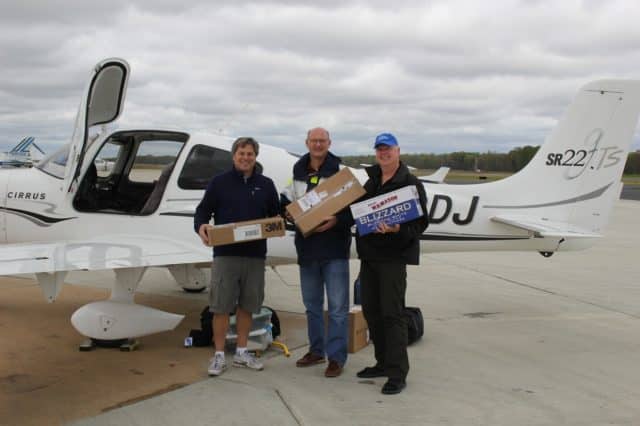
Loading medical supplies at JVW (Raymond MS) for St. Damien’s
The massive storm was still blocking our way so we weaved a path to Pensacola Florida (KPNS).
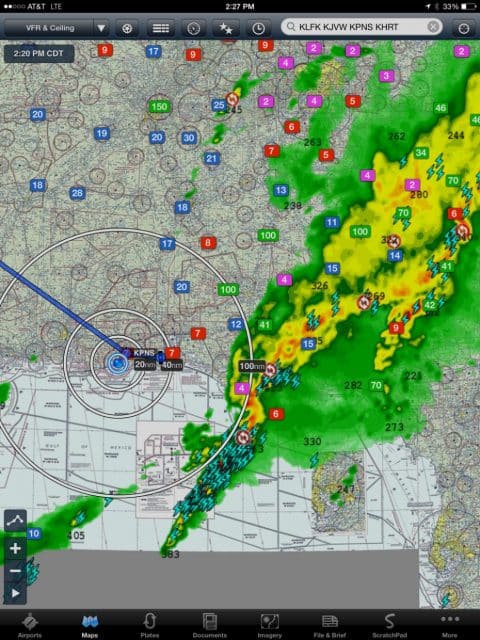
WX through Florida Panhandle
If you need to stop, Pensacola is a great place to visit. The FBO was extremely helpful and we spent some time at the Naval Aviation Museum. For aviators, it is definitely a place to visit. Just 30 minutes from the airport you arrive at the Pensacola Naval Air Station and the museum.

Pensacola Naval Aviation Museum
We flew down to Panama City, FL (KECP) for the night. The next morning the Radar was still depicting severe weather, so we maneuvered around the worst cells and headed to Fort Lauderdale Executive airport (KFXE).
Fort Lauderdale FL Exec (FXE) to Exuma, Bahamas (MYEF)
I always use Banyan Air, Fixed Based Operator (FBO), when at FXE. Don and Sueanne Campion, the owners, were extremely supportive of the earthquake relief efforts and Sueanne joined me in Haiti when we flew an adopted child and her father to the US.
On the flight to Exuma we were in the clouds intermittently, in between we could see the beautiful water that surround the islands. There are very few instrument approaches in the Bahamas, and none on the ‘Out’ islands, so after canceling our IFR flight plan we descended through the clouds and broke out at 2,500 feet AGL (also MSL) to see the Exuma island chain and Exuma International Airport (MYEF).
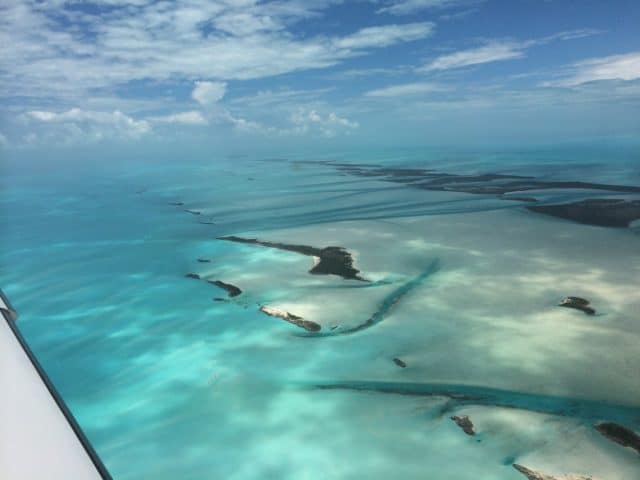
Approaching Exuma
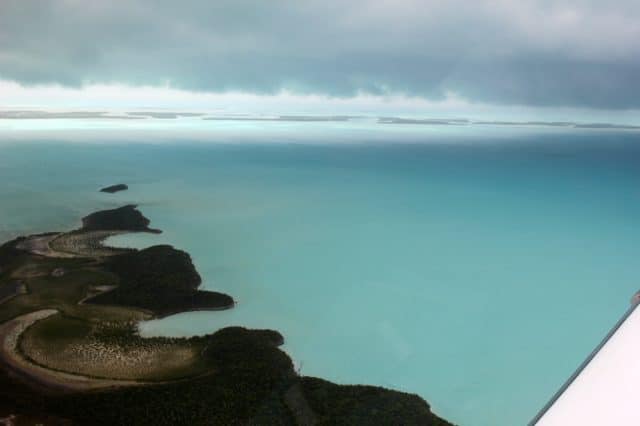
Turquoise waters off Exuma
The chain stretches over 120 miles and contains over 360 cays (islands). Exuma’s first European settlers were Loyalists fleeing the American Revolution, hence the largest settlement is named Georgetown after King George III. The folks at the Odyssey FBO are always nice to see, and I’ve used their services often. On my relief flights they would expedite all handling for me so I could continue my flights. This time was no exception. The Bahamas are one of my favorite places to fly, and I never tire of seeing the islands. After refueling at Odyssey Aviation, we launched for our longest over water leg to Port-au-Prince (360NM – 414SM).
Exuma, Bahamas (MYEF) to Port-au-Prince, Haiti (MTPP)
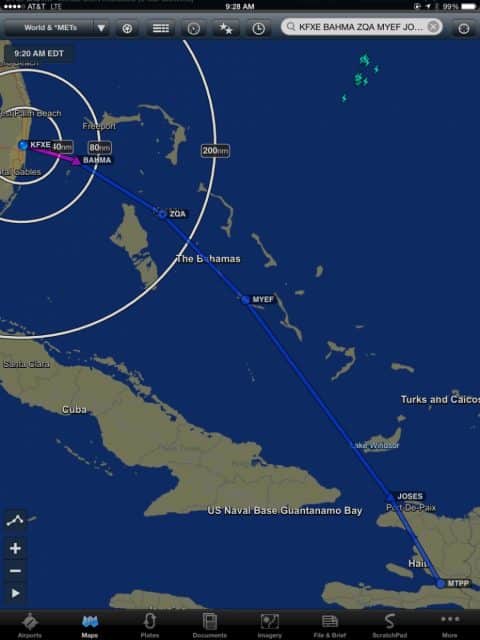
Florida (FXE) to Port-au-Prince (MTPP)
Our flight plan took us to ACMEE, then JOSES intersections before reaching Haiti. On the way you can see Cuba on our right, and Great Inagua island on the left. Great Inagua is a major waterfowl refuge, salt production site and a little used airport. There is little else on the large island, however it is nice to know that an airport might be close by, if needed!
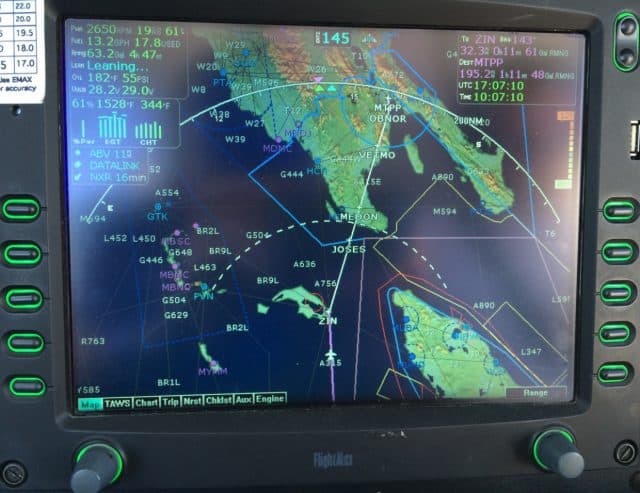
Approaching ZIN intersection – Great Inagua, Bahamas
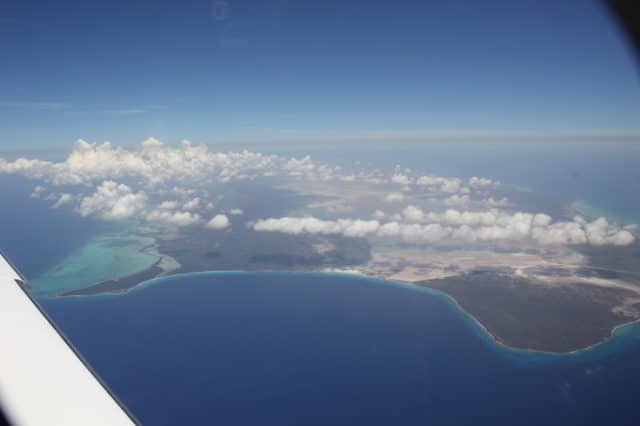
Great Inagua
At JOSES intersection we left US Air Traffic Control (ATC) and were told to contact Haiti ATC (Port-au-Prince Approach) sometime around the coast of Haiti, near Cap-Haïtien. Since the Haitians do not have RADAR for aircraft flow control and their communications systems don’t reach very far, it took a number of attempts to contact them. We finally connected with them well past Cap-Haïtien. Since there is no RADAR, each pilot must report their position and estimated time at the next waypoint. We were cleared for the RNAV (GPS) Rwy 28 approach. It is an interesting instrument approach with a number of step-down fixes in order to clear the terrain, with reporting at each one. Port-au-Prince (MTPP) airport is near the ocean and is in a large basin. I’ve made a number of night departures, which are interesting due to the high terrain in the area. There was some confusion with Haitian ATC since they had recently changed frequencies and the Jeppesen chart data did not agree with the Garmin GPS information, which was confounded by confusion of pilots approaching MTPP. We decide to monitor multiple frequencies and use our airborne aircraft traffic system – Honeywell TAS to confirm the location of other aircraft in the airspace. I didn’t want to rely on ATC for traffic separation, even in the clouds.
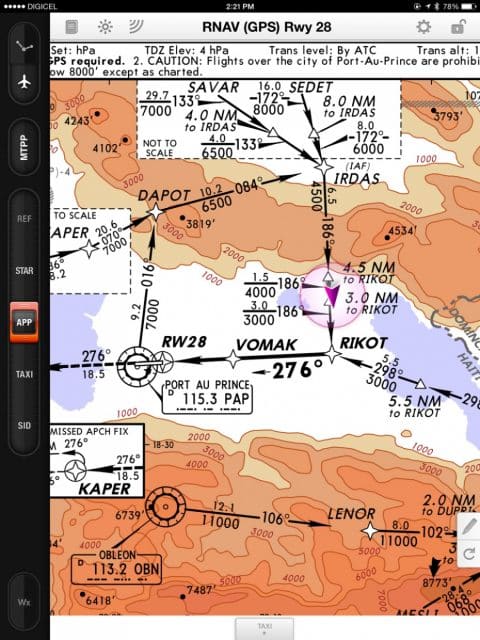
RNAV Rwy 29 MTPP – DJ approaching RIKOT
On an earlier night flight in 2010 you can see the obstacles on this departure from Port-au-Prince when I was flying a PC-12 after picking up relief workers for a flight back to Florida.

Departing MTPP at Night surrounded by obstacles
Port-au-Prince Haiti
We made it! Landing back at MTPP was amazing, it was great to be back in Haiti. After taxiing to the main terminal, the customs handling was easy, with the officials extremely helpful especially in light of our mission. We then taxied to the General Aviation terminal to unload medical supplies for St. Damien’s, other supplies for friends, and meet up with folks. One of my friends, Stacy Librandi now lives in Haiti after spending considerable time volunteering after the 2010 earthquake. Stacy offered to be our guide in Port-au-Prince (PaP) which was invaluable. The city can be challenging to navigate without someone with experience living there.
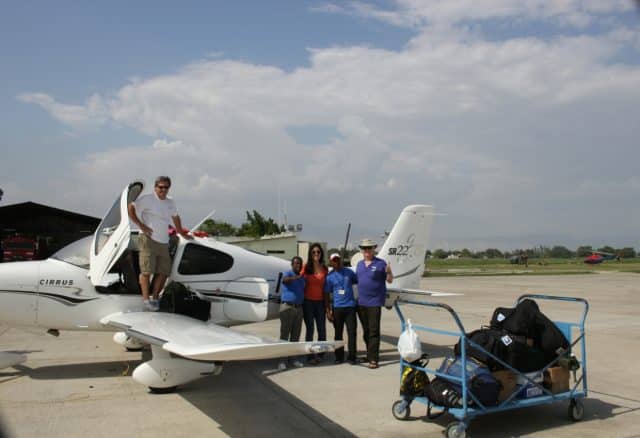
Unloading N412DJ at PAP
We couldn’t find many straight streets in Port-au-Prince that extend for any substantial length. For us it looked like an Escher print! Most of the earthquake rubble has been cleared, however damaged buildings are evident. It is a very vibrant city, with sidewalk vendors selling everything from mangos, to toothpaste, to cellphone SIM cards. In fact if you want to add minutes to your SIM card, you flag down someone who has a portable re-charge device, pay in Gourdes (the Haitian currency) and you are set. Since the traffic is so congested, you have plenty of time for the transaction. The most popular public transport is the Tap-Tap, a communal taxi loaded with as many people as is physically possible, and sometimes more.
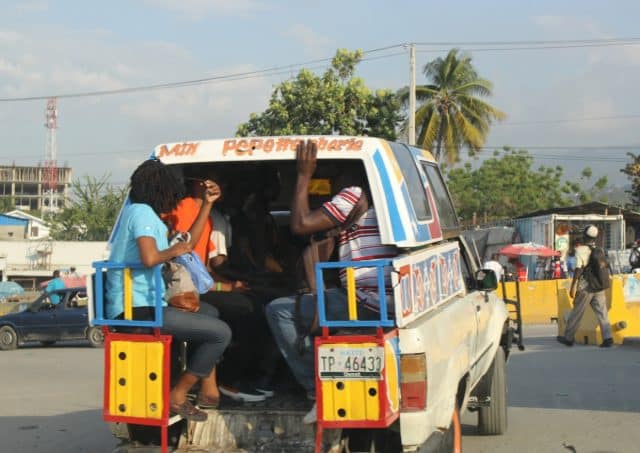
Tap Tap Port-au-Prince
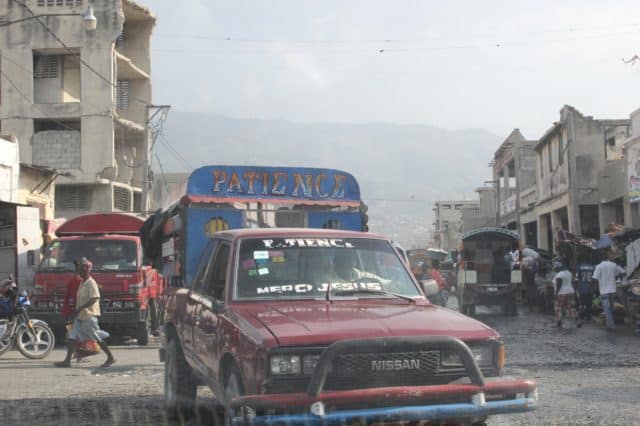
Patience you need to have some….
One of the busiest local markets is the Iron Market. Originally destined to be the train station in Cairo, it was assembled in Port-au-Prince in the late 1800s. Damaged during the 2010 earthquake, it was rebuilt and now houses over 900 vendors.
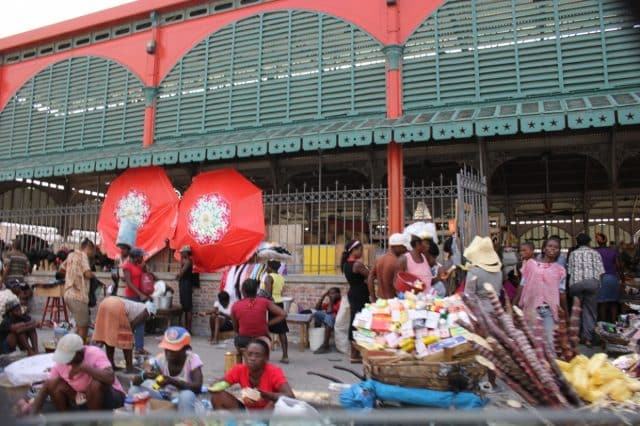
Port-au-Prince Iron Market
We stayed at a rather rustic B&B in the center of Peitonville, a suburb of Port-au-Prince. With roosters outside our window, no screens, cold water showers, and breakfast it was an adventure. There are a number of other lodging options in the city, including Best Western, Servotel (partially constructed with shipping containers), Hotel Montana (rebuilt after the earthquake) and a new Marriott under construction. Peitonville is home to a number of foreign workers, primarily working for foreign aid groups or NGOs (Non-Government Organizations). There are a number of quality restaurants, nightclubs, and other establishments in the area. We found excellent restaurants, some hidden behind nondescript doors, modern grocery stores, and a large number of street vendors selling fresh produce. One great restaurant is Magdoos, which is owned by a friend of Stacy’s.
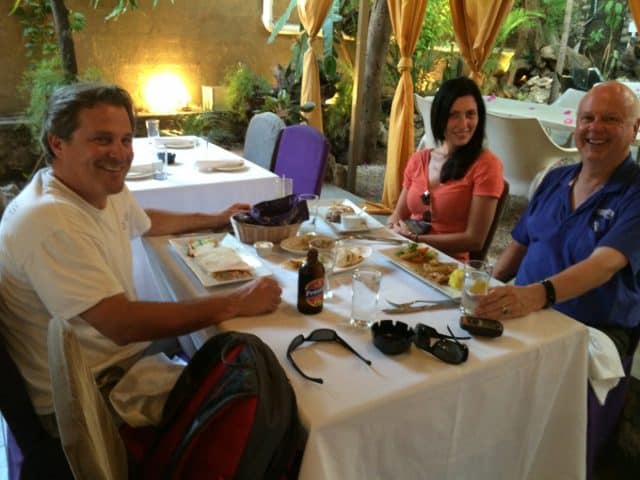
Dinner at Magdoos
Outside of these suburbs are contrasting areas of severe poverty and modern buildings. Haiti is trying to entice new investment and create job in a number of areas, including technology. The country has a significant challenge to rebuild the infrastructure, and more importantly, improve basic services to meet the needs of all of its citizens. A number of people still live in temporary housing, and in remnants of their once proud homes. Despite these challenges, it was heartening to see improvements in roads, hospitals, and commerce. All of which will help improve their lives.
Throughout our travels in Port-au-Prince I only felt in danger once, when attacked by a vicious dog, actually Stacy’s puppy. He was fascinated by the velcro strap on my sandals, opening and closing it repeatedly!
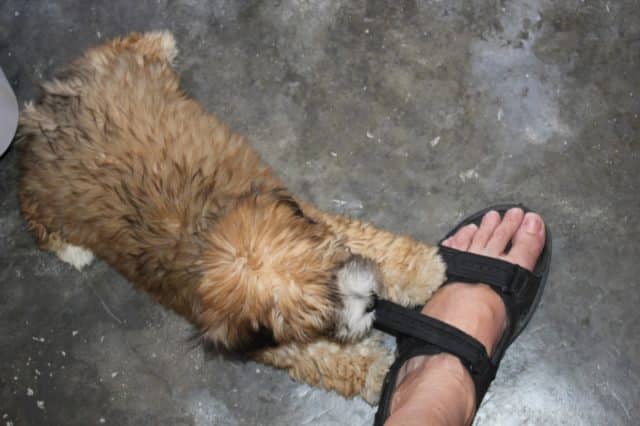
Haitian Attack Dog
We visited Haiti Communitere, which is a grassroots organization that initially provided disaster relief with a dedicated of volunteers, and was founded by a friend, Sam Bloch. In addition to providing help around the world, the Haiti group also is providing a valuable community-based center for people to explore alternative construction techniques, and even explore 3-D printing among other projects. The community participants have devised methods to build homes from discarded styrofoam food containers, common discarded items, and composting and biogas toilets. It is a great community resource and is located very near the Port-au-Prince airport.
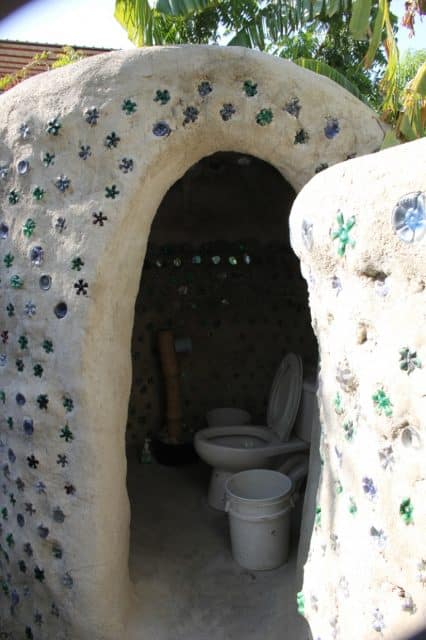
Recycled trash turned into a classy composting outhouse (Haiti Communitiere)
For those travelers seeking a more traditional vacation, one hour outside of Port-au-Prince is Indigo Beach, the former Club Med with facilities that may rival other caribbean resorts. Jacmel is another great city to visit. Heavily damaged by the 2010 earthquake, large portions have been rebuilt and is considered a cultural and art center of Haiti. During 2010 Jane and I stayed at a great hotel on one of our trips flying children to the US for medical treatment.
We visited St. Damien’s pediatric/maternity hospital near the airport, the recipients of some of our supplies. They have an excellent facility with many buildings, which survived the earthquake. They, along with a number of other hospitals, are providing a critical service to the Haitian people. The hospital is well run, with occasional help by visiting medical staff, project managers, and other volunteers. While there I discussed additional ways to possibly help them on future trips, which hopefully will happen.
Stacy and I wanted to explore the use of mobile GPS for emergency medical response in Port-au-Prince. Since the streets are a maze and extremely crowded, Stacy’s concept is to train EMTs who can use motorcycles to provide assistance before the arrival of ambulances. They may also double as road assistance. Garmin graciously provided several eTrex 20 GPs. I located maps of Haiti provided by the community source project OpenStreetmap. I was able to load them in the Garmin eTrex 20 units and they worked great and will be mounted on several motorcycles. We were able to navigate throughout Port-au-Prince (you can zoom into the street view) with ease. Prior to the earthquake, there were virtually no detailed road maps. The continual upgrading of the Haiti Open Streetmap project is encouraging.
Port-au-Prince (MTPP) to Les Cayes (MTCA)
It was interesting visiting Port-au-Prince, however one of my primary goals on this trip was to help the Consolation Center. We headed to the airport and while filing our flight plan to Les Cayes, I thought I recognized the official at the counter. After a few minutes, we both realized that we had met in 2010 at the Les Cayes airport. At that time, Edgar, was working at the operations office at the airport. His first child was born at that time, and his family needed some basic supplies. We found what he needed and brought him food, baby supplies, and toys for his child. Now with two children, it was great getting reacquainted and I hope to see him on future flights.
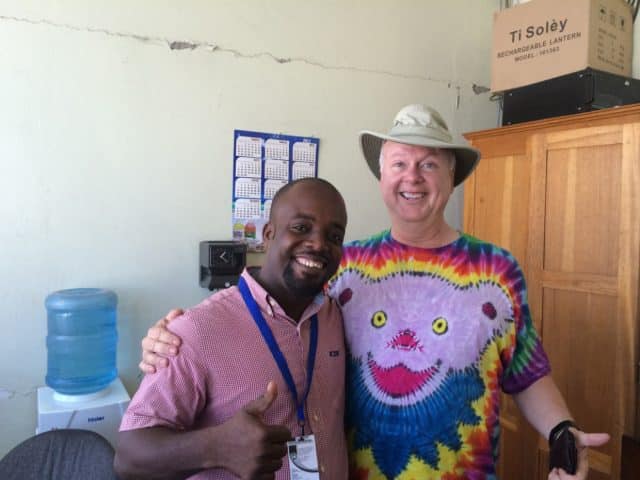
Edgar Laplante and Rich at PaP airport
George flew the leg over to Les Cayes, which is normally a 4 hour drive and only a 30 minute flight. We wanted to tour the coast so we made a detour to see the sights along the south coast. I had flown along the coast many times in 2010 and wanted to explore other areas that might be fun to visit in the future. It is very sparsely populated with few roads, yet there were some spectacular beaches along the way. I wanted to fly around Île à Vache located off the coast near Les Cayes, which was home to the pirate Henry Morgan in the 1600s. It is a beautiful island, regretfully the Haitian Government is using eminent domain to force the local population to leave so they can commercially develop the area. As has happened so many times before in many countries, the indigenous populations are removed by those more powerful.

Île à Vache – Haiti
Les Cayes, Haiti
Les Cayes is located right on the water, and the first impression is that the street layout actually appears to be organized, with straight roads and thoroughfares, in contrast to Port-au-Prince.
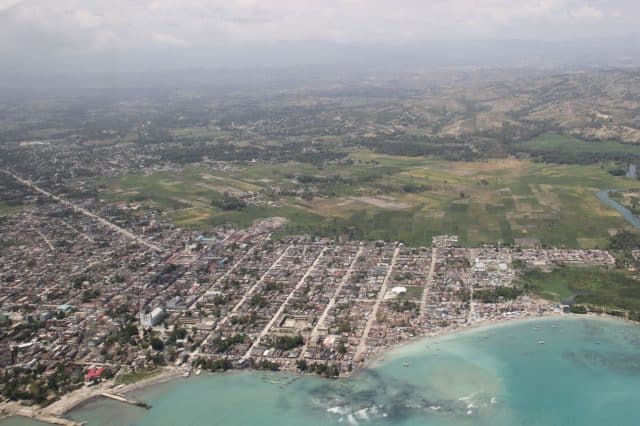
Aerial view of Les Cayes
The Les Cayes airport (MTCA) is very quiet, and landing there again great memories of helping people and meeting new friends. The airport surface is a tad rough, however it was an easy approach with fields surrounding the airport.
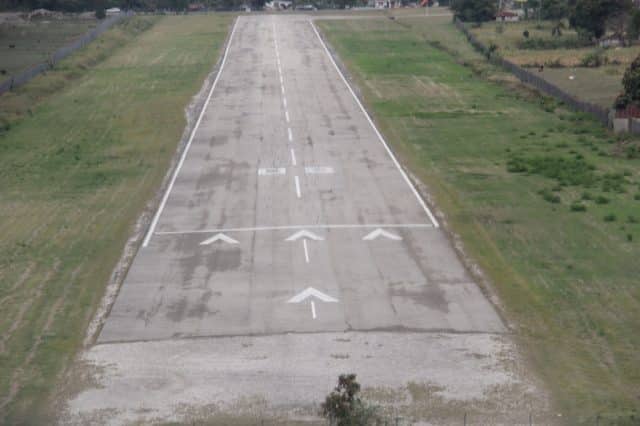
On Short Final RWY 8 – Les Cayes MTCA Airport
There were no tie-down points on the ramp, so with a few rocks and with help unloading we headed to the Consolation Center.
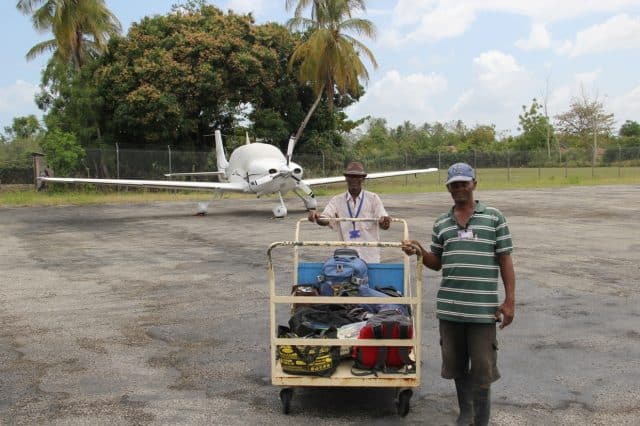
Unloading DJ again – this time at Les Cayes
Consolation Center/Centre le Reconfort
The staff at the Consolation Center have done an excellent job in expanding the orphanage and school. With a very practical approach to construction, layout, and agriculture, they have built a very efficient center for over 60 young girls and a school for 300+ boys and girls. They have expanded their farm, with the help of a group of farmers and agronomists from Iowa, with a wide variety of crops, chickens, goats, rabbits, and a few cattle.
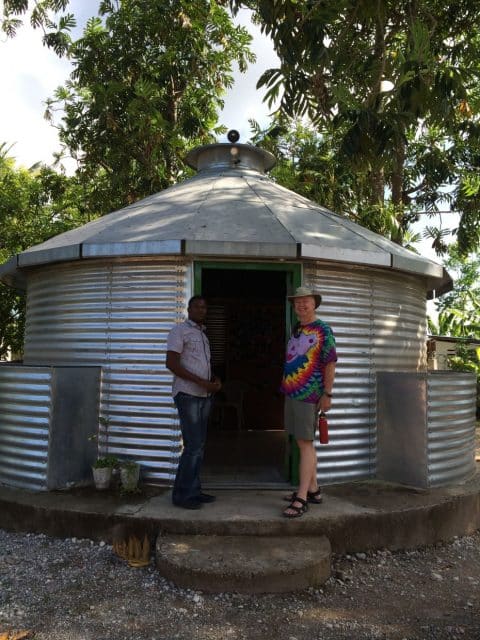
Eddy’s office which is a grain silo – easy to construct – storm resistant
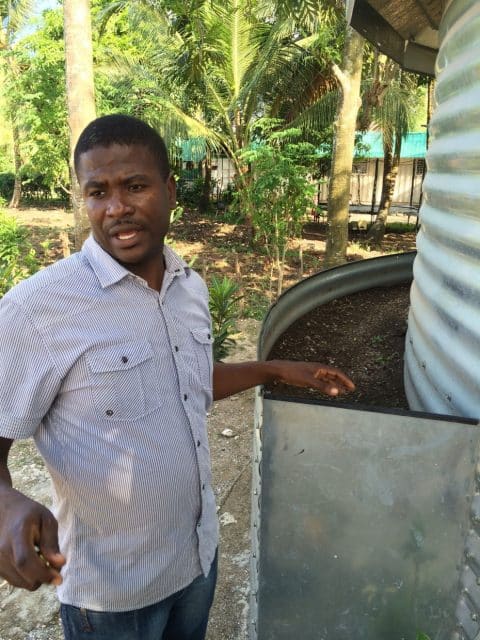
Eddy explaining how the silo base is anchored with rocks, then soil is added for a garden.
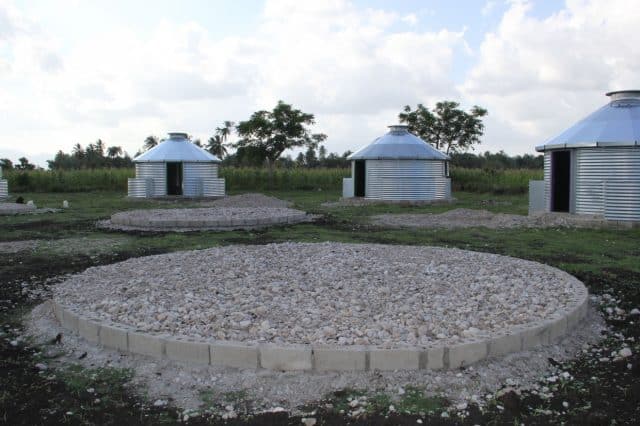
Site of the new Widows section of the Center.
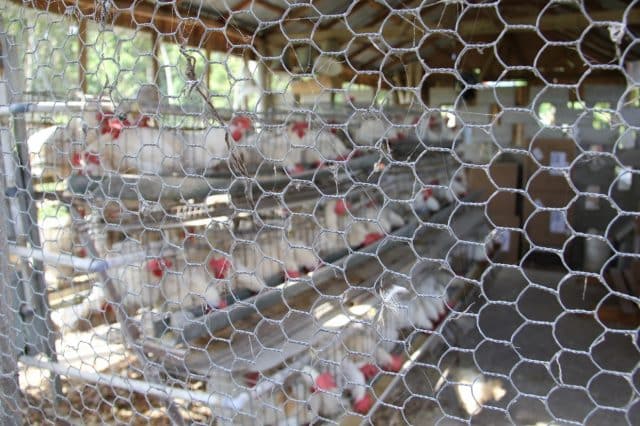
Chicken coop!
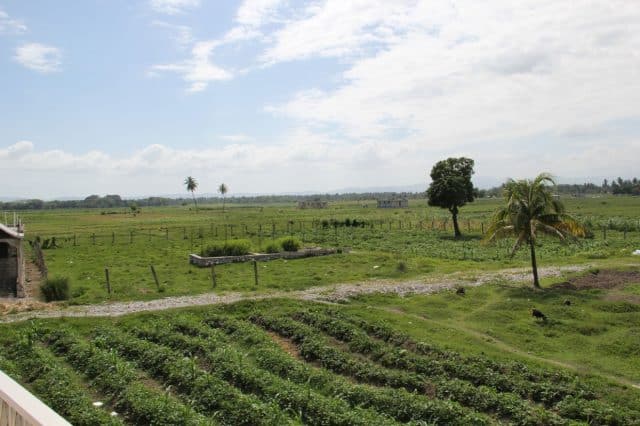
A portion of the Center’s farm. It looks like a scene from Iowa!
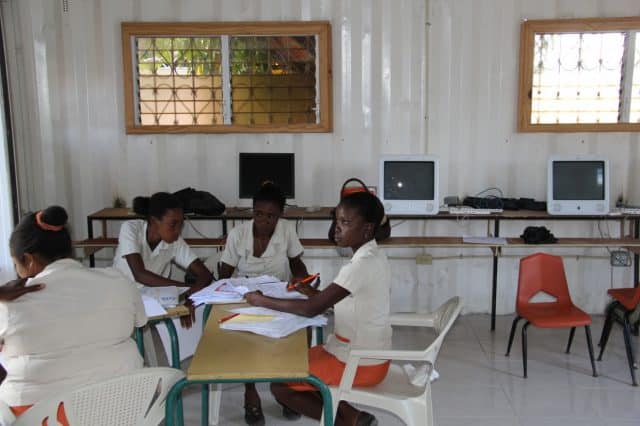
Teachers catching up after school
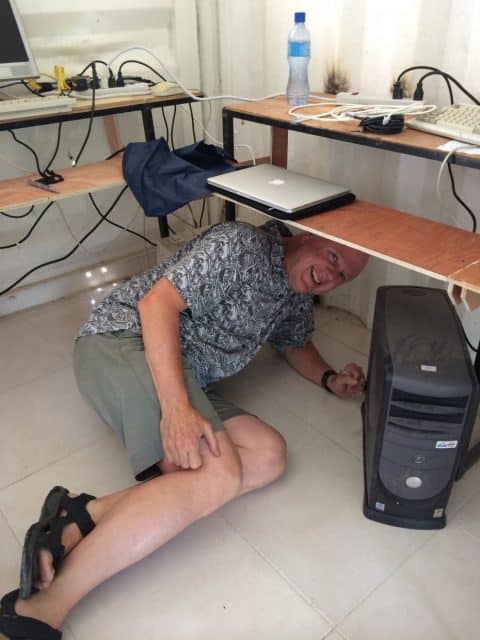
Computer tech support!
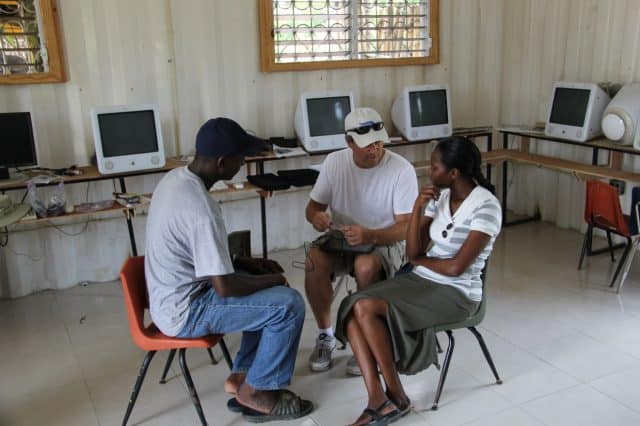
Computer knowledge transfer with Max and Djeune.
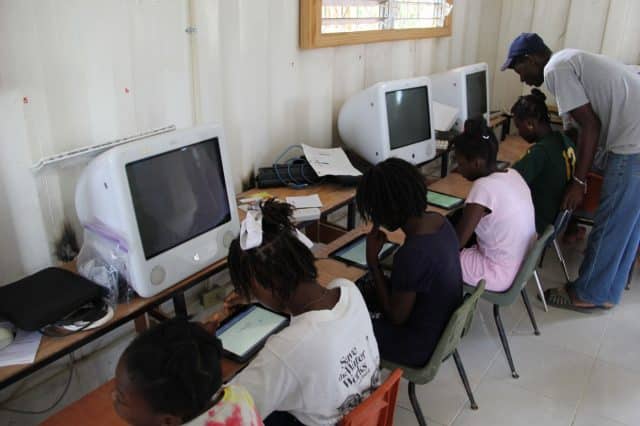
The girls trying out the new Android tablets in the classroom.
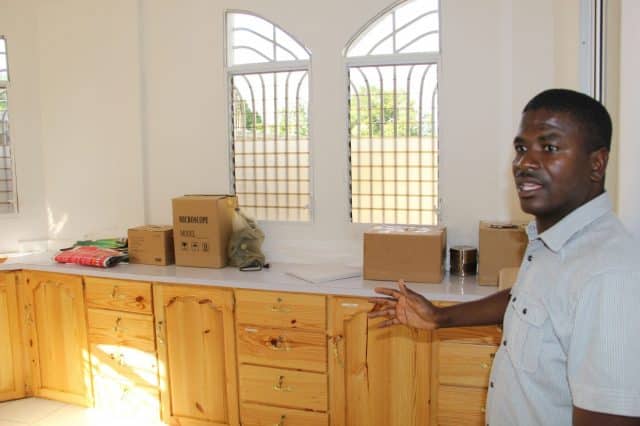
The Center’s new medical lab.
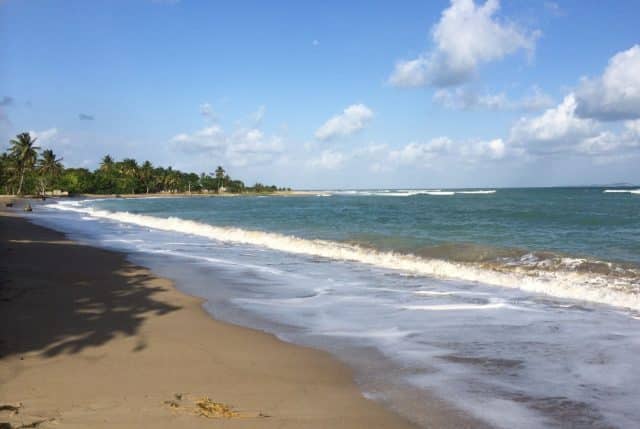
Gorgeous beach in Les Cayes
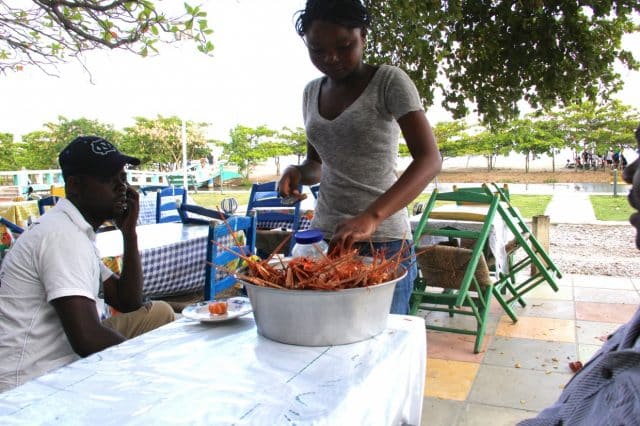
Lobster and fish dinner on the beach in Les Cayes
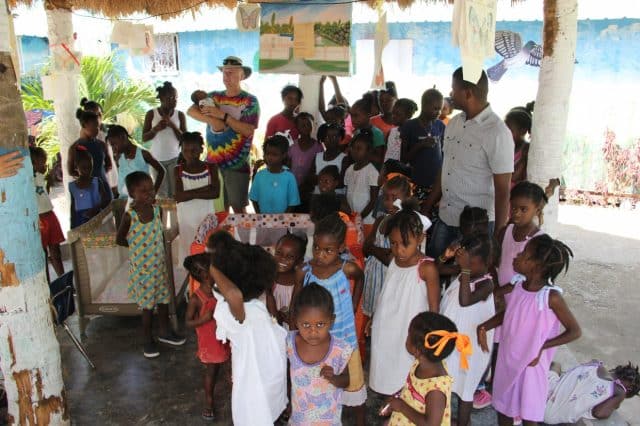
Eddy and Rich with the children at the orphanage
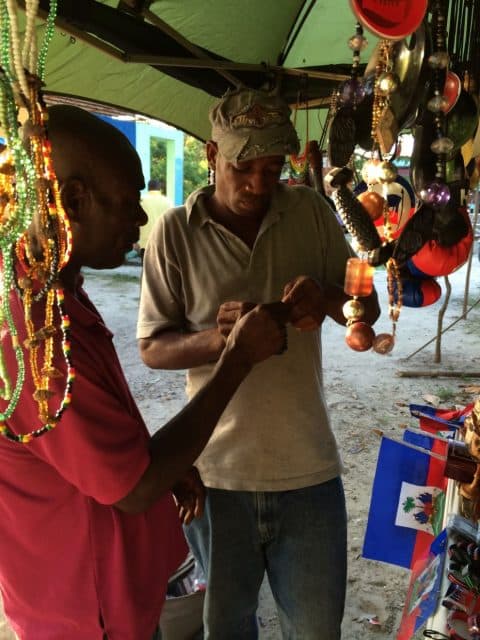
I met a Port Salut artist and asked him to make bracelets for our grand daughters.
We had a very productive visit in Les Cayes, reconnecting with friends, setting up equipment, and determining how to help the Center in the future. The stay was too short, and we were headed home, with a brief stay in the Bahamas.
Haiti to the Bahamas.
Leaving Les Cayes airport, we met Edgar’s successor, Raymond. He made the process easy, and fun. I filed a flight plan to leave Les Cayes headed to Cap-Haïtien, the Airport of Entry (AOE).

Rich and Raymond filing out paperwork
The flight back through the Bahamas was great, just this time Cuba was on our left.
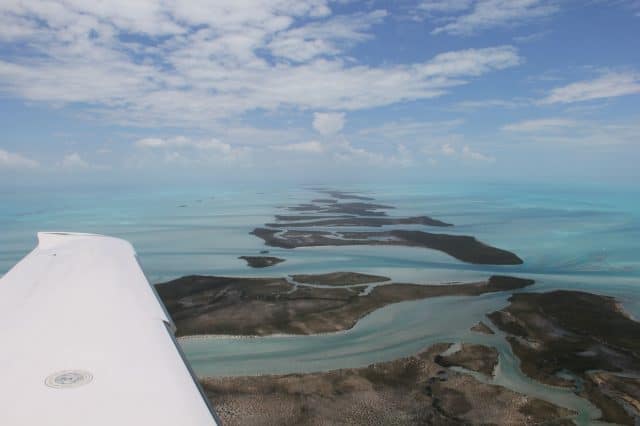
Back to the Exumas
After clearing Bahamas Customs and Immigration on Exuma, we headed to one of my favorite resorts – Hawk’s Nest on Cat Island. Hawk’s Nest has their own private airport right next to their resort. After you park, it is only 40 yards to the lobby, then only another 50 yards to the beach! For pilots, this is great. You can visit your plane often during your stay, and even take it for a spin around the islands. I have been known to hop in the plane and visit another island for lunch, or just to swim on a deserted beach.
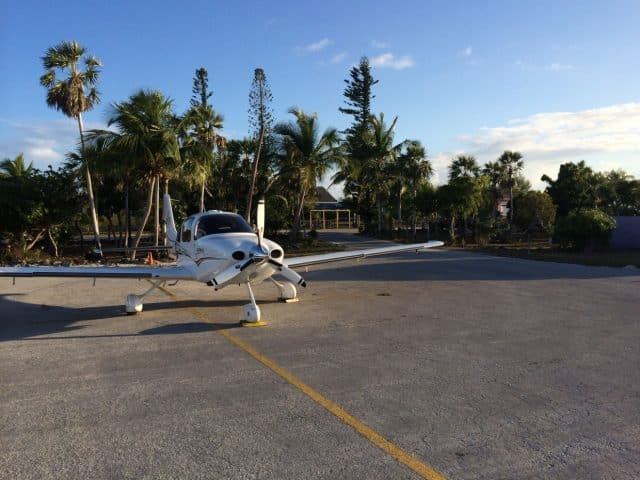
N412DJ parked at Hawk’s Nest airport.
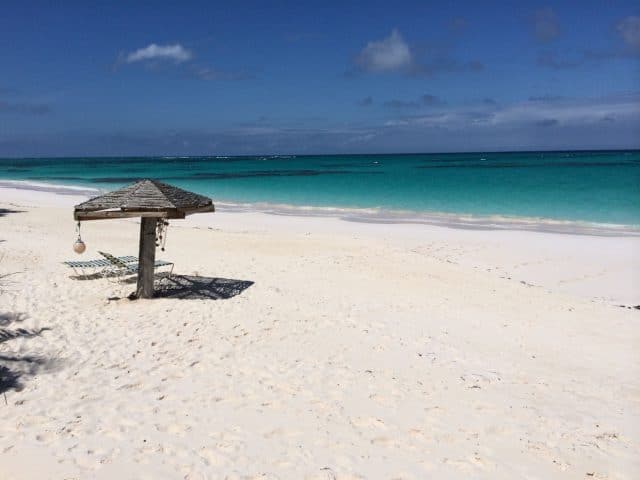
The beach at Hawk’s Nest, Cat Island.
One of the least inhabited islands in the Bahamas, there were only a few people where we stayed. George and I decided to explore some of the beaches elsewhere on the island to snorkel. At one deserted beach, I noticed a number of shoes that had washed ashore. I wondered if they may have come from a Haitian refuge boat that I heard had sunk offshore. While I walking on the beach a local Bahamian, Charlie, walked towards me. He was looking for tar balls, which are created by leaking fuel from boats, to melt and use to seal a tub at his Mom’s house at nearby Devil’s Point. I asked him if perhaps the shoes may have come from that boat. Charlie mentioned that a refuge boat had indeed sunk off shore. A 30 foot boat with over 200 people on board. While we talked, Charlie said “Some survived, and some perished…”. It seemed a poignant reminder, and another contrast, of our trip to Haiti.
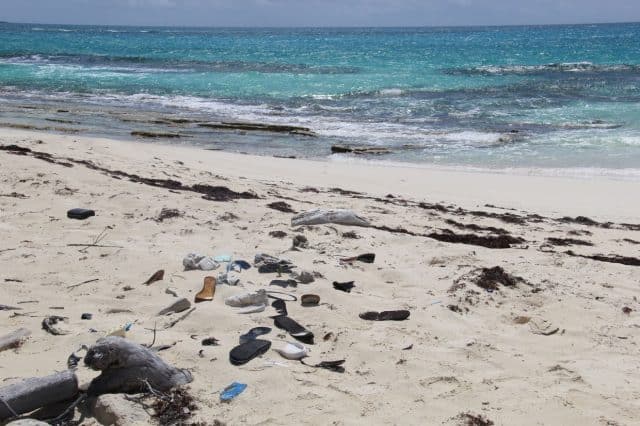
Shoes on the Cat Island Beach
Cat Island has a number of quiet, secluded places to stay. One is the Greenwood Resort on the east side of the island. Favored by divers, and those who just want to hang out, it was nice to visit. After a few hours it was time to head back and enjoy our last day before flying home from the Bahamas.
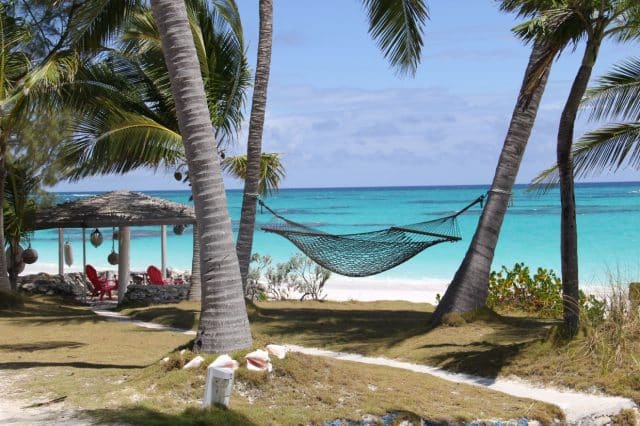
Greenwood Resort – Cat Island
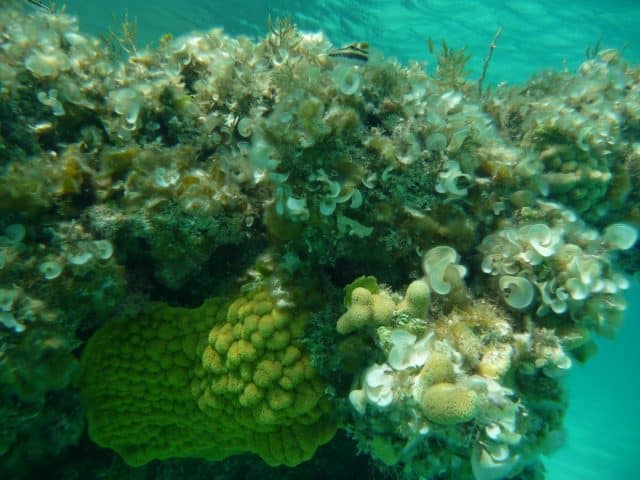
Various corals on reef at Cat island
Bahamas to San Diego
We left the Bahamas through the New Bight International airport (MYCB) since Hawk’s Nest is not an AOE. It is a short flight from Hawk’s Nest and the Immigration folks at the airport were nice, as usual.
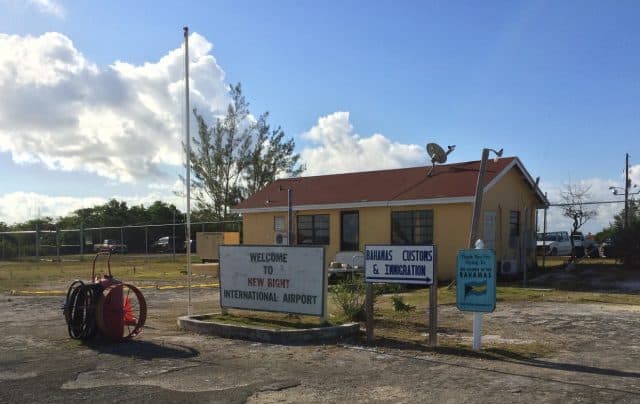
New Bight International Airport Bahamas
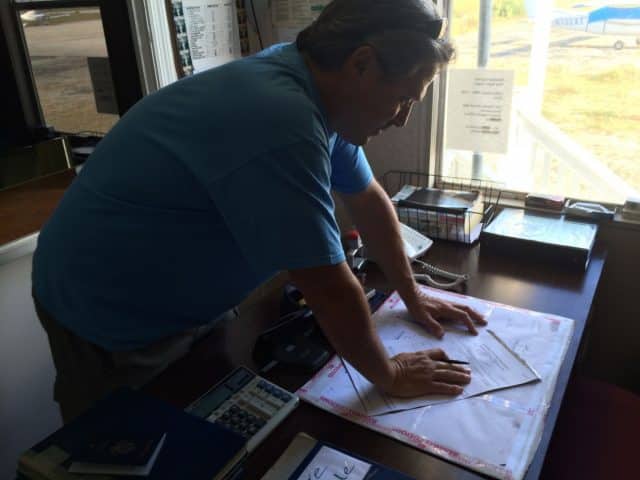
More paperwork at Night Bight airport
We flew back to Fort Lauderdale Executive (FXE) for US Customs and Immigration. Once you go through the process a few times, you realize how easy it is. If you are prepared and have everything in order it doesn’t take much time to be back in your airplane and on your way.
The weather was worsening across Florida, following a very typical storm pattern that I’ve seen many times. We decided to weave our way and head towards California and make it as far as possible in the same day. There were a few significant areas of precipitation and very heavy rain reported along our route. Tampa airport was temporarily closed due to extremely heavy rain, and it was right on our path home. I first filed IFR to KPIE (St. Petersburg). The weather was between us and KPIE, however I calculated that it might move out of the way. We could wait there until it cleared enough to maybe get to Tampe (KTPA). The Foreflight weather on the IPAD had slightly different information than the XM weather on our MFD. In any case we would hope that the worst would move out of our path.
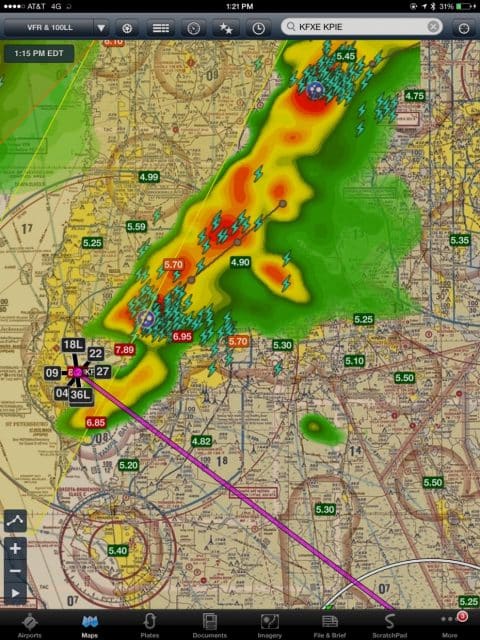
Foreflight weather KFXE to KPIE
As we approached KPIE the first series of cells were moving east, however another one behind was quickly approaching. By watching the trend of the cell movement and calculating our flight path, we determined one option would be to zig-zag and stay between the cells. The weather information indicated they were moving at 30-40 knots. We had a headwind heading to the northwest, however I knew that once we change direction back to the northeast we would have a significant tailwind, which would help propel us ahead of the second storm.
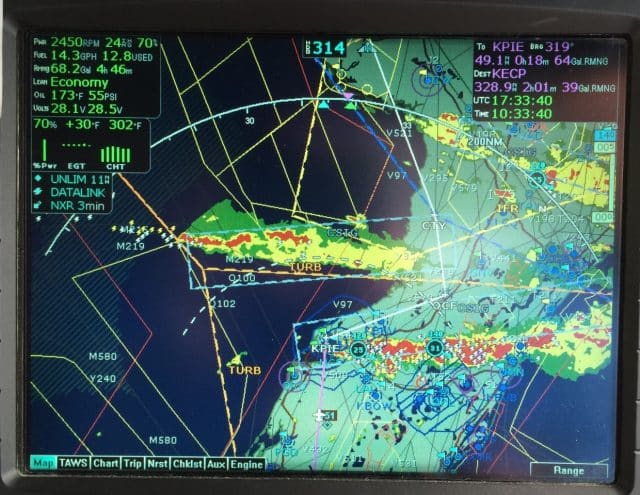
DJ XM Weather – Florida
We we were approaching the St. Petersburg/Tampa area we could see on our satellite weather feed a large number of lightning strikes. Using our onboard Lightning Detection system (Goodrich Stormscope) which can detect more type of strikes we could see a significant number of strikes on our path. We also had an advantage in that we can fly efficiently at lower altitudes, which allowed us to visually steer away from the largest clouds and stay below some of the cells, rather than try to navigate through them.
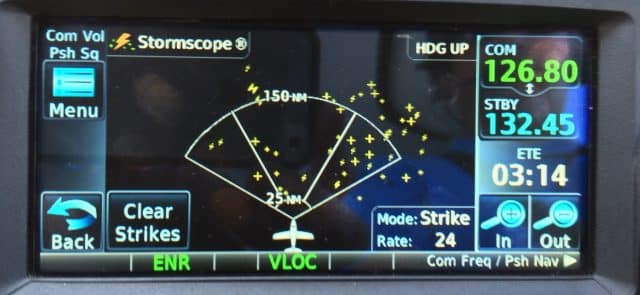
DJ’s Stormscope Lightning Detection of cloud-cloud and cloud-ground strikes
Our calculations worked perfectly, and ATC was extremely accommodating especially since I changed our routing numerous times over a short period to time, constantly changing our heading and even destination airport.
Along the way we stopped in Granbury, TX to visit a good friend whom I worked with in Haiti. Ric and his wife Wendy not only have worked for years as volunteer physicians in Haiti, but have also adopted 5 Haitian children. The first was Laney, the young girl who I flew out of Port-au-Prince late one night along with Ric who had just completed the adoption. Not wanting to leave her 4 siblings back in Haiti, Ric and Wendy spent 3 years adopting them to add to their other 3 children.
After 40 flight hours, 10 days, and 6500 miles we landed back at Montgomery Field (KMYF). That evening my first task, after kissing my wife, was to start visualizing and planning the next trip….
